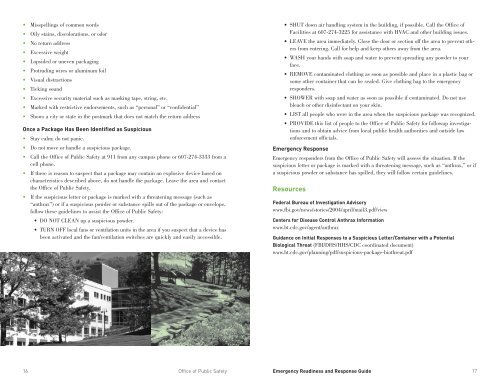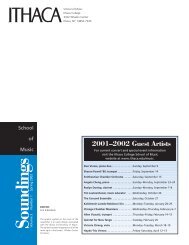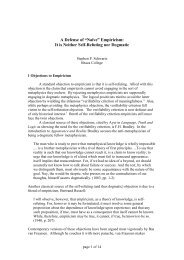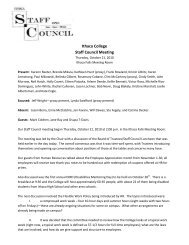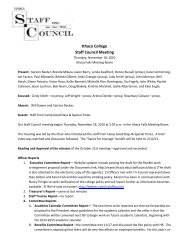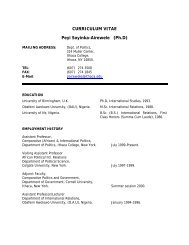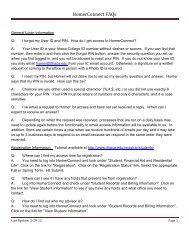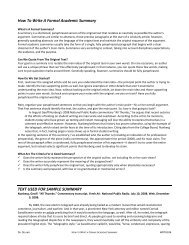Emergency Readiness and Response Guide - Ithaca College
Emergency Readiness and Response Guide - Ithaca College
Emergency Readiness and Response Guide - Ithaca College
Create successful ePaper yourself
Turn your PDF publications into a flip-book with our unique Google optimized e-Paper software.
• If an active shooter is outside your building, you should immediately seek cover in an<br />
attempt to conceal yourself <strong>and</strong> hide from the shooter. Proceed to a room that can be<br />
locked, close <strong>and</strong> lock all the windows <strong>and</strong> doors, <strong>and</strong> turn off all the lights; if possible,<br />
get everyone down on the floor <strong>and</strong> ensure that no one is visible from outside the room.<br />
One person in the room should call 911 or 607-274-3333, advise the dispatcher of what<br />
is taking place, <strong>and</strong> inform him/her of your location; remain in place until the police<br />
give the “all clear.” Unfamiliar voices may be the shooter attempting to lure victims<br />
from their safe space; do not respond to any voice comm<strong>and</strong>s until you can verify with<br />
certainty that they are being issued by a police officer.<br />
• If an active shooter is in the same building you are, you should immediately seek cover<br />
in an attempt to conceal yourself <strong>and</strong> hide from the shooter. Determine if the room you<br />
are in can be locked <strong>and</strong> if so, follow the same procedure described in the previous<br />
paragraph. If your room can’t be locked, determine if there is a nearby location that can<br />
be reached safely <strong>and</strong> secured, or if you can safely exit the building.<br />
• If an active shooter enters your office, classroom, or residence, try to remain calm.<br />
Call 911 or 607-274-3333 if possible <strong>and</strong> alert police to the shooter’s location; if you<br />
can’t speak, leave the line open, so the dispatcher can listen to what’s taking place. If<br />
there is no opportunity for escape or hiding, it might be possible to negotiate with the<br />
shooter; attempting to overpower the shooter with force should be considered a very last<br />
resort, after all other options have been exhausted. If the shooter leaves the area, proceed<br />
immediately to a safer place <strong>and</strong> do not touch anything that was in the vicinity of<br />
the shooter.<br />
• If you decide to flee during an active shooting situation, make sure you have an escape<br />
route <strong>and</strong> plan in mind. Do not attempt to carry anything while fleeing; move quickly,<br />
keep your h<strong>and</strong>s visible, <strong>and</strong> follow the instructions of any police officers you may<br />
encounter. Do not attempt to remove injured people; instead, leave wounded victims<br />
where they are <strong>and</strong> notify authorities of their location as soon as possible. Proceed to a<br />
safe location <strong>and</strong> do not leave campus until advised it is safe to do so by police.<br />
What to Expect from Responding Police Officers<br />
Police officers responding to an active shooter are trained to proceed immediately to the<br />
area in which shots were last heard; their purpose is to stop the shooting as quickly as possible.<br />
The first responding officers will normally be in teams; they may be dressed in regular<br />
patrol uniforms, or they may be wearing external bulletproof vests, Kevlar helmets, <strong>and</strong><br />
other tactical equipment. The officers may be armed with rifles, shotguns, or h<strong>and</strong>guns,<br />
<strong>and</strong> might also be using pepper spray or tear gas to control the situation. Regardless of how<br />
they appear, remain calm, do as the officers tell you, <strong>and</strong> do not be afraid of them. Put<br />
down any bags or packages you may be carrying <strong>and</strong> keep your h<strong>and</strong>s visible at all times;<br />
if you know where the shooter is, tell the officers. The first officers to arrive will not stop to<br />
aid injured people; rescue teams composed of other officers <strong>and</strong> emergency medical personnel<br />
will follow the first officers into secured areas to treat <strong>and</strong> remove injured persons.<br />
Keep in mind that once you have escaped to a safer location, the entire area is still a crime<br />
scene; police will usually not let anyone leave until the situation is fully under control <strong>and</strong><br />
all witnesses have been identified <strong>and</strong> questioned. Until you are released, remain at whatever<br />
assembly point authorities designate.<br />
General <strong>Guide</strong>lines for Action<br />
• Secure immediate area<br />
• Lock <strong>and</strong> barricade doors<br />
• Turn off lights<br />
• Close blinds<br />
• Silence cell phones<br />
• Block windows<br />
• Turn off radios <strong>and</strong> computer monitors<br />
• Keep occupants calm, quiet, <strong>and</strong> out of sight<br />
• Keep yourself out of sight <strong>and</strong> take adequate cover/protection (e.g., concrete walls,<br />
thick desks, filing cabinets, or other cover may protect you from bullets)<br />
• Place signs in exterior windows to identify the location of injured persons<br />
Contacting Authorities<br />
• Use 607-274-3333 to contact the <strong>Ithaca</strong> <strong>College</strong> Office of Public Safety dispatcher from<br />
a cell phone. Program this number into your cell phone now!<br />
• Dialing 911 from a campus phone will also connect with the <strong>Ithaca</strong> <strong>College</strong> Office of<br />
Public Safety.<br />
• Dialing 911 from a cell phone will connect you with the Tompkins County <strong>Emergency</strong><br />
Dispatch Center. Be sure to give the call taker your exact location.<br />
What to Report<br />
• Your exact location: building name <strong>and</strong> office/room number<br />
• Number of people at your specific location<br />
• Injuries: number injured, types of injuries<br />
• Assailant(s): location, number of suspects, race/gender, clothing description, physical<br />
features, type of weapons (long gun or h<strong>and</strong> gun), backpack, shooters’ identity if known,<br />
separate explosions from gunfire, etc.<br />
If doubt exists for the safety of the individuals inside the room, the area should remain<br />
secured.<br />
8 Office of Public Safety<br />
<strong>Emergency</strong> <strong>Readiness</strong> <strong>and</strong> <strong>Response</strong> <strong>Guide</strong> 9


